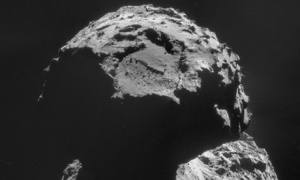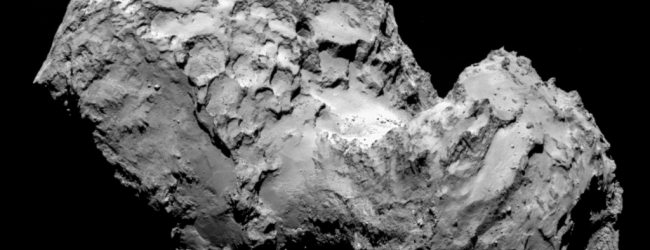 The moment has finally come. Six billion kilometres and 10 years into its mission, on Wednesday a spacecraft will attempt to place a lander on a speeding comet for the first time in history.
The moment has finally come. Six billion kilometres and 10 years into its mission, on Wednesday a spacecraft will attempt to place a lander on a speeding comet for the first time in history.
The European Space Agency’s £1bn Rosetta probe caught up with comet 67P in August and began flying around the giant lump of ice and dust to scan the surface for a landing site for Philae, its tiny lander.
After ruling out several sites as too dangerous, the agency settled on a one-square-kilometre landing spot it has named Agilkia. It is the best of the bunch, but there are still no guarantees that Esa can pull off one of the most ambitious manoeuvres in space exploration.
The Mont Blanc-sized comet is shaped like a rubber duck and has precipices and slopes to contend with. Its surface is pocked with holes and strewn with boulders. The difficulty of the landing is testament to how hard rocket science has become.
Any number of glitches could yet delay the landing. But if all goes to plan, Rosetta will unlock a spring-loaded mechanism at 9am GMT on Wednesday morning and gently nudge the lander towards the comet. For the next seven hours, Philae will descend 22km in silence, reaching its target on the “head” of the comet around 4pm GMT.
“Excitement is rising and so is our nervousness,” said Hermann Boehnhardt, lead scientist on the Philae lander. “For the moment, the focus is on the engineers and the lander and orbiter spacecraft and their subunits that have to do the job for the lander delivery and release.”
The lander, a cubic-metre box of electronics on legs, holds instruments that will analyse the comet and take images of its nucleus as it spews more and more dust and ice on its journey towards the sun. The measurements will help scientists answer the question of whether a bombardment from comets billions of years ago brought water and simple organic molecules to Earth, ultimately paving the way for life.
A small glitch struck on Monday night, when the Philae lander awoke but remained on its backup computer instead of switching to its main computer. The problem was resolved by implementing a procedure endorsed by IT departments the world over: mission controllers in Darmstadt turned it off and on again.
The problem had threatened to delay the landing, but scientists on the team said on Tuesday that after resolving the issue, the lander had warmed up well and that the original landing schedule was still feasible.
More important than being on time, the lander must be on target. If Philae strays outside its landing zone, it has a greater chance of toppling over in the more hostile terrain. To land in the right place, mission controllers must take into account the dust and water vapour billowing off the comet and its oddly shaped gravitational field. On touchdown, Philae will use harpoons and icescrews to secure itself to the comet.
The comet is already losing up to five litres of water a second, which blasts from the icy body in jets. As the comet gets closer to the sun, the jets of water vapour grow ever more intense. If all goes well, Rosetta may deliberately fly through one of the jets next summer.
Fred Jansen, mission manager, gives the landing a 75% chance of success. This was the original percentage the agency wanted when it committed to the mission back in 1992.
When the bizarre shape of the comet was revealed in July, some thought the landing was going to prove impossible. But months of work have now boosted confidence that the mission has a good chance of delivering Philae to the surface safely. “Twenty years ago we said we wanted to land on a comet we knew nothing about. There will be risks,” said Jansen.
Andrea Accomazzo, Rosetta flight director, has worked on the mission for 18 years. “The mission is already a major achievement in space exploration history,” he said. “Exploration implies risk. If you are not ready to take the risk, then you shouldn’t do exploration.”
The mission will continue, whether or not Philae makes it to the surface safely. The landing would be “the cherry on the cake”, said Jansen.
Rosetta has already gathered more data than has ever been collected before about a comet and the mission is set to run until at least December 2015.
Source:
http://www.theguardian.com/science/2014/nov/11/rosetta-landing-comet-67p-churyumov-gerasimenko-philae-lander
Image Description:
The comet as seen by the Rosetta on 6 November. The landing site chosen for its lander, Philae, is close to the top of the image above a large boulder-filled depression. Photograph: ESA/Rosetta/NavCam/PA
Comments
comments



 The moment has finally come. Six billion kilometres and 10 years into its mission, on Wednesday a spacecraft will attempt to place a lander on a speeding comet for the first time in history.
The moment has finally come. Six billion kilometres and 10 years into its mission, on Wednesday a spacecraft will attempt to place a lander on a speeding comet for the first time in history.




